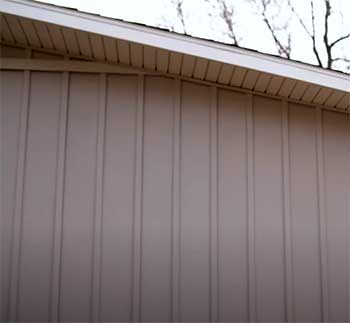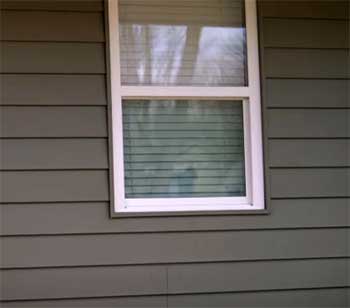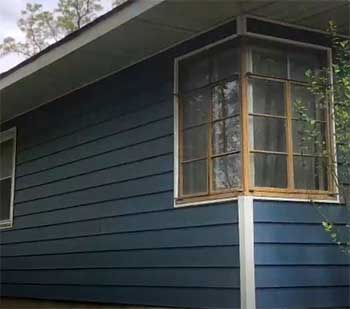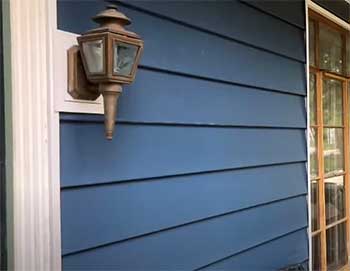CraneBoard fiber cement siding has become an increasingly popular choice for homeowners looking to re-side their homes. Made from sand, cement, and cellulose fibers, CraneBoard is known for its durability, fire resistance, and insulation capabilities. However, like any siding material, it is not without its potential drawbacks.
In this comprehensive guide, we’ll walk through the most common CraneBoard siding problems homeowners report and provide tips on how to avoid or fix them.
Common Problems With CraneBoard Siding
Here is a list of those issues:
- Cracking
- Delamination
- Efflorescence
- Mold or Mildew Growth
- Loose or Damaged Siding
- Paint Peeling or Fading
- Uneven Color Changes Over Time
- Holding Moisture and Warping
- Difficulties With Installation
Let’s elaborate those problems a little bit!
Cracking
Cracks in CraneBoard siding are one of the most frequently reported issues. There are a few reasons this durable material can become cracked:
- Improper Installation

One of the biggest causes of cracks is improper installation. Fiber cement siding needs to be installed on a very flat, even surface, with no uneven spots.
If the substrate isn’t perfectly smooth, it can lead to cracks over time as the siding settles or shifts.
Using a wavy substrate or failing to properly space the siding panels leads to stress that causes cracking.
Following manufacturer instructions for proper gapping and using furring strips levels out any uneven spots in the substrate.
- Not Allowing for Expansion
CraneBoard will naturally expand and contract with temperature changes throughout the seasons. When installing siding, it’s crucial to allow for this movement by leaving the recommended gaps between boards. Cutting boards too short or tightly butting them against trim prevents natural expansion and causes cracking.
- Impact Damage
Cracks can also develop when CraneBoard siding is impacted, even lightly. Dropping tools on it during installations or ball impacts are common culprits. Unfortunately, once fiber cement cracks, the damage cannot be repaired. The only solution is to replace any cracked boards.
Preventing impact damage by exercising care around the siding is key.
Delamination
Delamination is when the finish on the CraneBoard starts to peel, bubble, or separate from the siding. Moisture getting in between the coating and the board leads to this problem over time. Preventing moisture issues can help avoid delamination down the road:
- Keep Gaps Clear
It’s important that vertical overlaps and gaps remain free of debris and sealed properly so water cannot penetrate behind the siding. Regularly inspect gaps and clear out any built-up debris. Avoid using compressed foam gap fillers, which can dislodge over time.
- Maintain Caulking
Caulking around windows, corners, seams, and trim should be maintained. When caulk starts cracking or peeling, replace it to keep a good seal. Latex or polyurethane caulk works best.
- Slope Siding Down
Always make sure the siding is installed sloping downwards so water can run off. Flat horizontal siding allows moisture to pool and seep in. Adding furring strips to create a downward slope prevents this.
- Keep Gutters Clean
Clogged gutters overflow and pour water down the siding, leading to delamination over time. Make sure gutters are kept clear of debris, angled properly, and draining well away from the home’s foundation.
Efflorescence

Efflorescence is the white powdery substance that sometimes develops on CraneBoard siding.
It’s caused when water seeps behind the siding and reaches the cement substrate, releasing lime.
As the water evaporates, it leaves the chalky lime deposits behind.
Efflorescence is more of an aesthetic concern than a performance issue. To minimize it:
- Avoid Excess Water Exposure
Points where water accumulates, like around sprinklers or improper roof flashings, can contribute to efflorescence. Fix any drainage issues and divert water away from the siding. Extended contact with wet soil should also be avoided.
- Seal Joints
Any joints, gaps, or penetrations in the siding should be properly caulked and sealed to prevent moisture ingress behind the siding. Flashing should be integrated properly around all windows, doors, and openings.
- Use Rainscreen System
Installing CraneBoard as part of a rainscreen system creates an air gap between the siding and the sheathing. This allows any moisture that gets behind the siding to dry out before reaching the cement.
- Clean and Repaint
In most cases, efflorescence can be removed with white vinegar and water. For more stubborn deposits, TSP cleaner helps break down mineral deposits while scrubbing. Repainting also helps conceal discoloration.
Mold or Mildew Growth

In warm, humid climates, CraneBoard siding may develop dark spots of mold, mildew, or algae over time.
Like efflorescence, this is primarily an aesthetic concern, rather than damaging the integrity of the siding.
Preventing excessive moisture behind the siding helps avoid mold or mildew growth:
- Increase Sun Exposure
Allowing good sunlight exposure helps reduce moisture and prevents the damp conditions mold and mildew need to grow. Strategic tree trimming can allow more sunlight to reach siding.
- Improve Ventilation
Good airflow on the backside of the siding discourages mold growth. Creating a rainscreen system improves ventilation and allows any moisture that gets behind siding to evaporate rather than sitting and molding.
- Use Mold-Resistant Paint
When it’s time to repaint the siding, choose a high-quality acrylic exterior paint formulated with mold and mildew inhibitors. This helps repel fungal growth.
- Clean Regularly
Mild mold or mildew growth can be removed by scrubbing the siding with detergent and water, or a diluted bleach solution for tougher stains. Avoid using a pressure washer, which can damage the siding.
Loose or Damaged Siding
It’s possible for CraneBoard siding panels to become warped, dented, cracked or even detached from the home over time. Preventing impact damage during installation helps avoid some of these issues.
But severe weather, age, and improper initial installation can also be causes. Check for loose, warped, or cracked pieces during annual home inspections and replace them as needed with matching siding panels.
Paint Peeling or Fading
CraneBoard needs to be painted for protection from weather and to look its best. But over time, the paint may start chipping, flaking, or peeling off the siding. Or the color may start to look faded and dull. To avoid paint issues:
- Use High-Quality Exterior Paint
The type and quality of paint used on CraneBoard siding makes a big difference in longevity. 100% acrylic latex exterior paints provide maximum durability and adhesion. Avoid cheaper paints that can peel or fade quickly in the elements.
- Prep Surface Properly
For the paint to adhere properly, the siding surface needs to be clean and properly prepared. Pressure washing, scrubbing with detergent, scraping/sanding, and priming ensure the new paint bonds well.
- Maintain Paint Regularly
Plan to repaint the siding about every 5-7 years to keep it looking fresh and protected. Address any peeling or cracking paint right away with spot touch ups before it spreads.
Uneven Color Changes Over Time

It’s common for CraneBoard siding to lighten over time after prolonged sun exposure.
This can result in uneven color if some areas of siding are shaded while other sections are sunnier.
Using darker color paints can help minimize this natural lightening effect.
If uneven fading does occur, thoroughly cleaning the siding before repainting helps even out the color.
Also Read: Everlast Siding Issues.
Holding Moisture and Warping
In rare cases, CraneBoard siding may exhibit warping or twisting, particularly with bare or unpainted panels. This occurs when the siding absorbs excess moisture, causing the boards to swell and change shape as they dry out.
Ensuring proper installation with adequate gaps allows airflow and drainage. Keeping the siding painted also helps protect it from moisture absorption issues. In humid climates, a rainscreen system is recommended during installation to allow ventilation and drainage behind the siding.
Severely warped or misshapen siding boards need replacement to maintain proper aesthetics and performance.
Difficulties With Installation
While fiber cement siding is designed for DIY-friendly installation, CraneBoard does have some tricky aspects that can prove challenging, such as:
- Precise cuts – the tough fiber cement boards require specialty cutting tools like carbide-tipped saws. Imprecise field cuts may compromise proper gapping or overlaps between boards.
- Heavy weight – full CraneBoard panels are heavy, bulky, and difficult for one person to maneuver onto the side of a home.
- Hidden fasteners – CraneBoard uses a clip system to hide fastener holes, which is trickier than simple nailing. Improperly spacing the clips leads to cracking or loosening.
- Working around details – wrapping exterior trim elements or working around fenestrations take extra precision. Poor corner seals or window flashing can let in moisture.
Hiring experienced installers is highly recommended to avoid improper installation issues. Following manufacturer guidelines closely is key for best results.
Finding Matching Replacement Pieces
CraneBoard siding has been manufactured for over two decades, with adjustments to color palettes and product specifications through the years. If older siding needs spot repairs, matching the existing style, pattern, and color through CraneBoard can prove difficult or impossible in some cases.
Knowing the installation date and retaining any extra pieces helps ensure the closest color match for repairs or expansions.
Otherwise, full residing is required for altered or discontinued products.
CraneBoard Siding Costs More Upfront
While durable and long-lasting, CraneBoard fiber cement siding comes at a higher initial price point than some other sidings like vinyl or wood. Full install costs range from $6-8 per square foot on average.
The enhanced durability and lifespan come with added cost. Homeowners need to weigh the value of the product and its lower long-term maintenance against the initial price investment.
Frequently Asked Questions About CraneBoard Siding
Yes, CraneBoard is considered an excellent quality siding product overall when properly installed. The fiber cement boards are durable, impact resistant, non-combustible, and provide good insulation. CraneBoard resists rotting, insects, and moisture damage and requires very low maintenance compared to wood siding products. It provides long-lasting curb appeal with dimensional stability. The thicker 1/2” panels are ideal for impact protection. With proper installation and care, CraneBoard siding should last 50 years or more.
The R-value of standard CraneBoard siding panels is R-1.8, meaning it provides a moderate level of thermal insulation. The R-value measures the material’s ability to resist heat flow. CraneBoard’s fiber cement composition helps block heat transfer compared to vinyl or metal sidings which have no insulating R-value at all. For improved insulation, CraneBoard’s insulated C-Board product offers R-3.0 without taking up any additional wall space. This provides excellent insulation for energy efficiency and added noise reduction.
While insulated siding like CraneBoard C-Board improves energy efficiency, there are a few potential drawbacks:
1. Higher upfront cost than standard siding
2. Heavier weight requiring sturdy bracing
3. Difficult to wrap around curved walls or custom shapes
4. Not ideal for damp climates without good ventilation due to trapped moisture
5. Can make exterior walls thicker, potentially impacting windows or trim
6. EPS foam risks absorption of exterior moisture
7. Less durable foam backing compared to fiber cement may warp
Proper installation leaving ventilation gaps, use of rainscreen system, and keeping insulation dry minimizes these risks.
On average, CraneBoard siding costs $6.50 – $8.00 per square foot fully installed. This is comparable to other premium fiber cement brands. Basic 8” lap siding starts around $2.40 per square foot for materials, then installation labor typically adds $4-5 per square foot for a professional siding crew. Thicker 1/2 panels cost slightly more. Insulated C-Board siding ranges from $9-11 per square foot installed.
CraneBoard is more costly than vinyl ($3-5 per sq.ft. installed) or wood siding ($4-6 per sq. ft) but is also more durable. Costs vary based on region, installation complexity, materials ordered, local labor rates, and other factors. Get an exact quote for your project based on total square footage and specifics.
CraneBoard provides a long return on investment through decades of low-maintenance use. Avoid potential added costs of improper DIY installation by hiring experienced siding crews. With proper care and regular cleaning/repainting, CraneBoard siding should last 50+ years.
Final Thoughts
CraneBoard fiber cement siding provides beautiful, durable, and insulating exterior protection for homes. However, like any siding, it is not immune to potential issues if improperly installed or maintained. Cracking, delamination, efflorescence, and paint failure are commonly reported problems.
Preventing moisture intrusion and following manufacturer installation guidelines helps minimize these issues. Hiring experienced installers and implementing proper maintenance and repair ensure CraneBoard siding performs for decades, living up to its reputation as a leading fiber cement siding brand.
With a long lifespan and infrequent need for replacement, the higher upfront investment in CraneBoard siding pays dividends over time compared to vinyl, wood, and other less durable alternatives.
